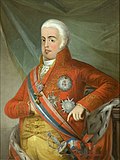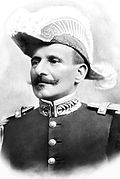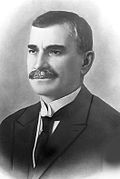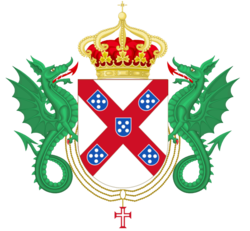Colonial Brazil (1500–1815)
House of Avis
Brazil is discovered by Portuguese navigators on April 22, 1500, and becomes a Portuguese colony.
| Name | Lifespan | Reign start | Reign end | Notes | Family | Image |
|---|---|---|---|---|---|---|
Manuel I
| 31 May 1469 – 13 December 1521 (aged 52) | 22 April 1500 | 13 December 1521 | Cousin of John II Grandson of Edward I | Aviz  | 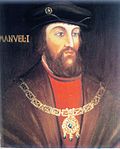 |
John III
| 7 June 1502 – 11 June 1557 (aged 55) | 13 December 1521 | 11 June 1557 | Son of Manuel I | Aviz  |  |
Sebastian I
| 20 January 1554 – 4 August 1578 (aged 24) | 11 June 1557 | 4 August 1578 | Grandson of John III | Aviz  |  |
Henry I
| 31 January 1512 – 31 January 1580 (aged 68) | 4 August 1578 | 31 January 1580 | Son of Manuel I Brother of John III Great-uncle of Sebastian | Aviz  |  |
Anthony I
| 1531 – 28 August 1595 (aged 64) | (Disputed) 24 July 1580 | (Disputed) 1583 | Grandson of Manuel I Nephew of Henry I | Aviz  |  |
House of Habsburg
The House of Habsburg , known as the Philippine Dynasty, is the house that ruled Portugal from 1581 to 1640. The dynasty began with the acclamation of Philip II of Spain as Philip I of Portugal in 1580, officially recognized in 1581 by the Portuguese Cortes of Tomar. Philip I swore to rule Portugal as a kingdom separate from his Spanish domains, under the personal union known as the Iberian Union.
| Name | Lifespan | Reign start | Reign end | Notes | Family | Image |
|---|---|---|---|---|---|---|
Philip I
| 21 May 1527 – 13 September 1598 (aged 71) | 17 April 1581 | 13 September 1598 | Grandson of Manuel I Nephew of Henry I | Habsburg  |  |
Philip II
| 14 April 1578 – 31 March 1621 (aged 42) | 13 September 1598 | 31 March 1621 | Son of Philip I | Habsburg  |  |
Philip III
| 8 April 1605 – 17 September 1665 (aged 60) | 31 March 1621 | 1 December 1640 | Son of Philip II | Habsburg  |  |
House of Braganza
The House of Braganza , also known as the Brigantine Dynasty, came to power in 1640, when John II, Duke of Braganza, claimed to be the rightful heir of the defunct House of Aviz, as he was the great great grandson of King Manuel I. John was proclaimed King John IV, and he deposed the House of Habsburg in the Portuguese Restoration War.
| Name | Lifespan | Reign start | Reign end | Notes | Family | Image |
|---|---|---|---|---|---|---|
John IV
| 19 March 1604 – 6 November 1656 (aged 53) | 1 December 1640 | 6 November 1656 | Great-great-grandson of Manuel I | Braganza  |  |
Afonso VI
| 21 August 1643 – 12 September 1683 (aged 40) | 6 November 1656 | 12 September 1683 | Son of John IV | Braganza  |  |
Peter II
| 26 April 1648 – 9 December 1706 (aged 58) | 6 November 1683 | 9 December 1706 | Son of John IV Brother of Afonso VI | Braganza  |  |
John V
| 22 October 1689 – 31 July 1750 (aged 60) | 9 December 1706 | 31 July 1750 | Son of Peter II | Braganza  |  |
Joseph I
| 6 June 1714 – 24 February 1777 (age 62) | 31 July 1750 | 24 February 1777 | Son of John V | Braganza  |  |
Mary I
| 17 December 1734 – 20 March 1816 (aged 81) | 24 February 1777 | 20 March 1816 | Daughter of Joseph I | Braganza  |  |
